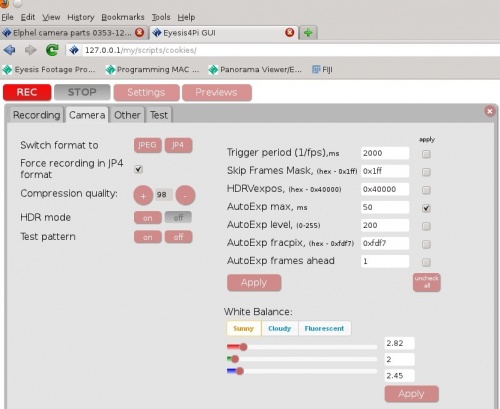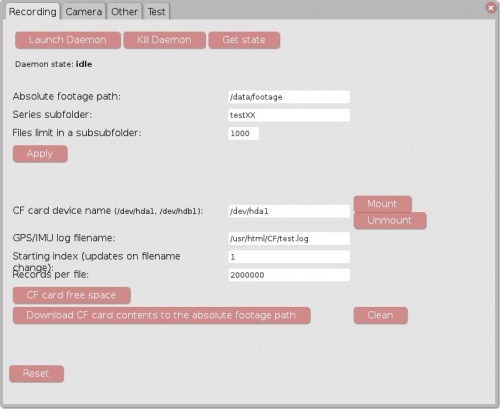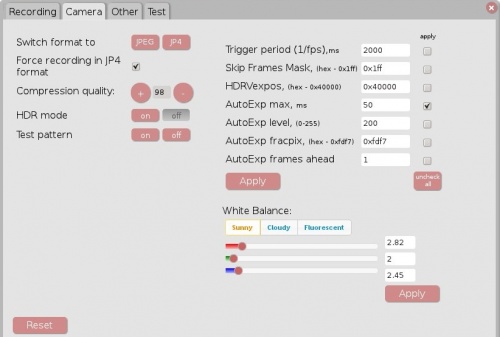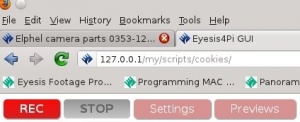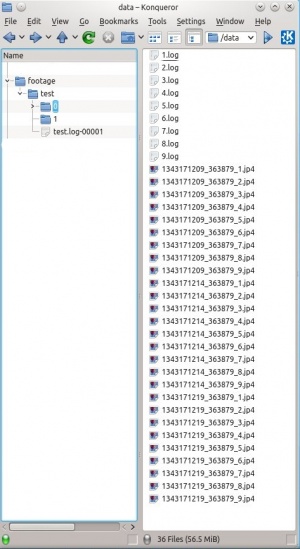Eyesis4Pi 393 User Guide - Recording
From ElphelWiki
Contents
Download & Install
Install GUI to the device that will be used for recording. There are several ways to install it:
Terminal:
cd <any-path> git clone https://github.com/Elphel/eyesis4pi-393-gui.git git pull (repeat any time to get the latest)
GitHub.com:
https://github.com/Elphel/eyesis4pi-393-gui
Follow the instructions in INSTALL.txt:
1. (For Kubuntu 16.04) Install the following packages, terminal: sudo apt-get install apache2 php5.6 php5.6-curl 2. Make the src folder visible to the web server: 2a. Create a link, terminal: "sudo ln -sf <path-to-eyesis4pi_gui-folder> /var/www/eyesisgui" 2b. Or copy all the files to /var/www/eyesisgui. Note: "/var/www" is the (apache2) web server's document root folder. (for recording to the device over network only) 2c. Make the footage root folder "/data/footage" writable for everyone.
Equipment/Package
- Eyesis4Pi 393
- Switch
- PC / Laptop
Power On
- Turn the switch on.
- Connect the camera's ethernet cables to the switch. Boot takes about 1 min.
Important Notice: Use a fan to cool the camera's pole when shooting indoors.
Network Set Up
- Connect the PC to the Gigabit port of the switch.
- Configure the PC's network settings (Kubuntu Network Configuration Guide):
IP address: 192.168.0.68 (example) Mask: 255.255.255.0
Note: Eyesis4Pi 393 default IP addresses: 192.168.0.161-163
System Tests
- Open the GUI page (the address is bookmarked in the Firefox and in the Chrome). The GUI address is:
http://127.0.0.1/eyesisgui/index.html
- Go to the "Settings" -> "Test"-tab:
- Follow the Open the test page-link, the tests are:
1. All the modules are online. 2. GPS locked 3. IMU detected 4. Internal CF cards are present
Setting recording parameters: storage paths
- Check paths at the Settings -> Recording-tab
Absolute footage path - the path to the folder where all the footage series are stored. Must be writable to everyone. Series subfolder - created automatically Files limit in a subfodler - number of files stored in a subfolder inside Series subfolder CF card device name - GPS/IMU log is saved to the internal CF cards. On the master camera they are /dev/hda1 & /dev/hdb1 GPS/IMU log file name - absolute path (in the master camera)+ log base name Starting index - logs are named as follows - [base_name]-[index] Records per file - number of records per log file. New file: an incremented index is added to the base name.
Setting recording parameters: camera settings
- Check camera settings at the Settings -> Camera-tab
Trigger period,ms - 1/FPS. Skip frames mask - hex 0x1ff - bit[8]=enable, bits[7:0] - 1 - record frame, 0 - skip frame - in an 8-frame sequence. HDRVexpos - in the HDR mode - the darker frame multiplication coefficient to get exposure for the lighter frame. AutoExp max, ms - the autoexposure value limit. AutoExp level - value of a pixel at which the autoexposure works. AutoExp fracpix - number of pixels below the Autoexp level. AutoExp frame ahead - number of previous frames used for calculatin the current frame exposure. Compression quality - JP4/JPEG compression quality.
HDR mode - at the fps rate the dark and the bright images alternate.
Skip Frames Mask: 0x1ff - frames are not skipped, camera is triggered at Trigger period. 0x155 - the camera is triggered at Trigger period/2 but only every other frame is recorded. It makes autoexposure adapt quicker and in the HDR mode records only normally exposed images skipping the underexposed ones.
Recommended values for 1 fps: Trigger period = 1000 (ms) Skip Frames Mask = 0x155 HDR mode = On
Recording
- Record-button to start recording
Stopping
- Stop-button for stop.
Downloading IMU/GPS Log
- After stopping - go to the Settings -> Recording-tab to download the IMU/GPS log.
Checking the Recorded Footage
- Check the footage at the Absolute footage path - each panorama set should consist of 9 images named with a timestamp of when it was taken plus the index of the camera (seconds_microseconds_index.jp4):
Note: Missing files most likely means that the FPS is too high.
